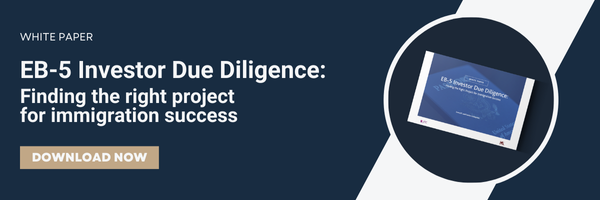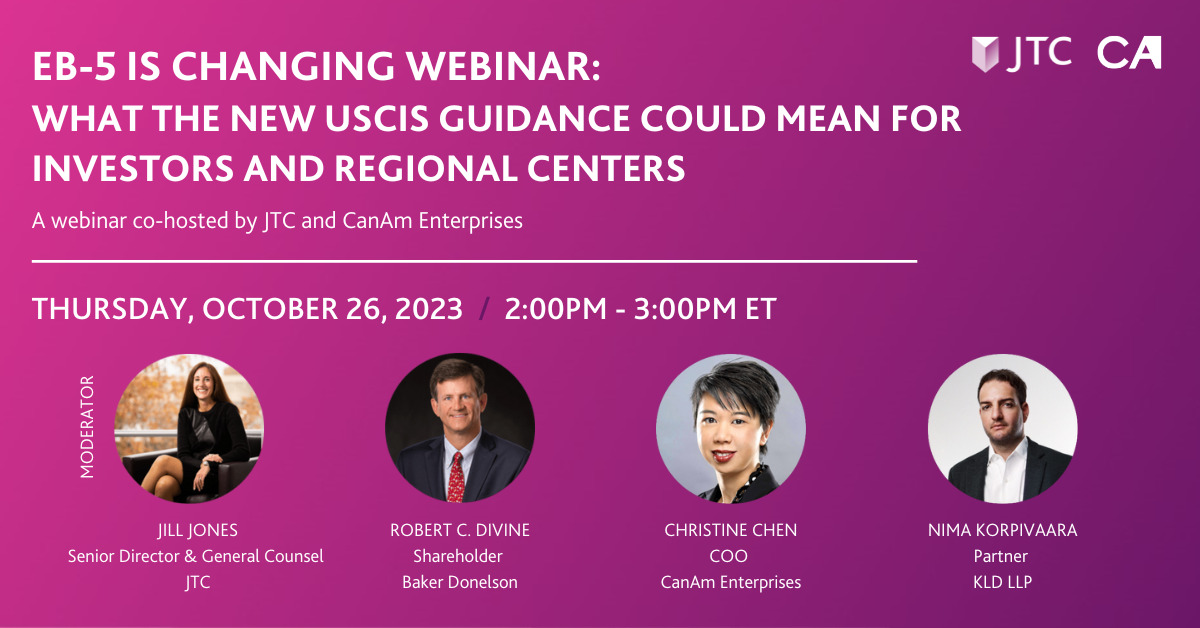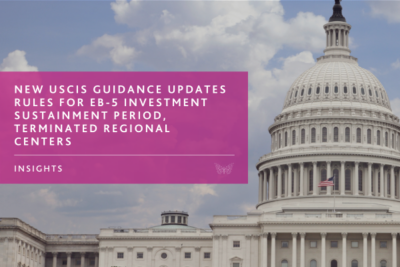The EB-5 Reform and Integrity Act (RIA) of 2022 brought significant changes to the sustainment period requirement. Specifically, the RIA indicates that post-RIA investors’ capital investments must be expected to remain invested for not less than two years. USCIS has since posted guidance on its website interpreting this provision of the RIA, which guidance is currently being challenged in court. Having recognized early on that the sustainment requirement under the RIA is multi-layered, new, and possibly subject to further USCIS interpretative guidance (itself subject to reversal by court decision), CanAm took a proactive approach to adjust its project selection and underwriting criteria to ensure that EB-5 investment timelines closely align with real market conditions that reduce risks for investors and enables them to meet their respective sustainment periods even as interpretations and guidance continue to evolve.
CanAm’s Thoughtful Approach to the EB-5 Sustainment Period and Loan Structuring Post-RIA
At CanAm, we have always approached EB-5 project structuring with a conservative and investor-focused mindset, ensuring that our projects comply with the most stringent interpretations of USCIS policies. This approach has been particularly critical in our interpretation of the sustainment period post-RIA and in how we structure the length of our EB-5 project loans. By prioritizing compliance, security, and predictability, we have safeguarded our investors’ ability to complete their immigration journey successfully.
The Evolution of the EB-5 Sustainment Period Requirement
Before the RIA, EB-5 investors were required to sustain their investment for the duration of their conditional residency period, often resulting in prolonged and uncertain investment hold times due to USCIS processing delays, especially when certain countries faced visa backlogs. The RIA revised this requirement, explicitly stating that post-RIA investors must sustain their investment for a minimum of two years. However, USCIS guidance did not specify the exact start and end dates of this period or address practical considerations regarding job creation and fund deployment. These uncertainties quickly became key areas of industry discussion.
While some stakeholders advocated for the shortest possible investment period to attract investors, CanAm took a different approach, prioritizing compliance and investor security. Walter Gindin, CanAm’s General Counsel, has played a pivotal role in analyzing and interpreting these changes. Speaking on the sustainment period in CanAm’s recent “Putting the 2-Year Sustainment Period into Context” webinar, he stated, “From a risk management perspective, we have always taken the most conservative approach. For us, that means ensuring that our projects meet the sustainment requirement in a way that will stand up to USCIS scrutiny, no matter how the policy evolves.” This philosophy has guided CanAm in structuring projects that protect investors while maintaining compliance with the latest regulatory requirements.
A Conservative and Thoughtful Structuring Approach
One of the most significant ways CanAm has implemented this conservative philosophy is through the careful structuring of its EB-5 project loan terms.
A key aspect of CanAm’s sustainment strategy was defining the timing of capital deployment. CanAm determined that the most conservative interpretation of the USCIS language required all EB-5 capital to be fully deployed into the job-creating entity (JCE) and actively at risk before the sustainment clock could start. For some projects, such as construction developments, the drawdown period can take 12 to 18 months, depending on the schedule.
Only then could the required two-year sustainment period begin, extending the EB-5 investment term to at least three years after the initial loan funding. To account for any unexpected project delays or USCIS processing issues, CanAm added an additional six-month buffer to ensure that, under no circumstances, would an investor need to redeploy their investment at the end of the EB-5 investment term. This approach led CanAm to establish a minimum 3.5-year loan term to ensure that all post-RIA investments meet USCIS requirements now and in the future.
 Christine Chen, CanAm’s Chief Operating Officer, emphasized this point during the “EB-5 Due Diligence” webinar: “We structure our projects with sufficient flexibility to ensure that the sustainment requirement is met under any interpretation. This means that even if policies shift or processing times extend beyond expectations, our investors are protected.
Christine Chen, CanAm’s Chief Operating Officer, emphasized this point during the “EB-5 Due Diligence” webinar: “We structure our projects with sufficient flexibility to ensure that the sustainment requirement is met under any interpretation. This means that even if policies shift or processing times extend beyond expectations, our investors are protected.
 Walter Gindin reinforced this approach in the same webinar, stating, “The last thing we want is for an investor to face complications at the I-829 stage because their funds weren’t properly sustained. By structuring our projects conservatively, we eliminate those risks.”
Walter Gindin reinforced this approach in the same webinar, stating, “The last thing we want is for an investor to face complications at the I-829 stage because their funds weren’t properly sustained. By structuring our projects conservatively, we eliminate those risks.”
Get Access: Watch the Full Webinar – EB-5 Due Diligence: Navigating Key Investment Considerations for Success
Real-World Impact: Protecting Investors from Uncertainty
Beyond meeting USCIS sustainment requirements, CanAm ensures that its EB-5 loan terms align with project timelines, job creation requirements, and successful exits. By structuring loans in accordance with real market conditions rather than short-term investor preferences, CanAm helps avoid the risks that may arise when USCIS policies evolve.
Walter Gindin highlighted this in CanAm’s “EB-5 Due Diligence” webinar: “We ensure that our projects are structured so that deployment aligns with real economic activity, ensuring compliance while reducing the risk of prolonged capital hold periods.” This contrasts with more aggressive structuring methods that may introduce risks if USCIS policies shift or investors face unforeseen delays.
Moreover, Christine Chen noted in the “Putting the 2-Year Sustainment Period into Context” webinar that CanAm’s loan structuring accounts for real estate market fluctuations and ensures liquidity. “If we structure loans too aggressively or with unrealistically short terms, we put both immigration and repayment at risk. Our focus is on structuring loans that reflect real market conditions and allow for successful exits,” she explained.
To align with commercial real estate cycles and job creation timelines, CanAm deliberately structures its loans to ensure investment success. While some regional centers may prioritize shorter loan terms to attract investors, CanAm maintains a more measured approach, ensuring compliance with USCIS requirements while maximizing job creation and capital repayment.
A 3.5-year loan term allows for ground-up construction, which typically takes 18-24 months, followed by 12-18 months for stabilization before refinancing or sale to repay the EB-5 investment. For projects where job creation extends beyond construction to operations, the EB-5 investment term must be long enough to capture all job creation for investors’ I-829 petitions.
In fact, CanAm has walked away from prospective EB-5 projects that did not meet its minimum 3.5-year loan term. In the current high-interest-rate environment, many developers seek shorter-term financing to wait for lower rates. CanAm has declined multiple projects requiring only 2-year financing because of the potential risk to investors when USCIS evaluates sustainment compliance.
CanAm believes its conservative approach to the sustainment period and loan structuring will provide tangible benefits for investors. In CanAm’s “Putting the 2-Year Sustainment Period into Context” webinar, Christine Chen reinforced this point: “We are committed to making sure that, regardless of how USCIS interprets sustainment in the future, our investors will be covered. That has always been our approach and remains our priority.”
Looking Ahead: A Commitment to Conservative, Investor-Centric Structuring
As the EB-5 landscape continues to evolve, CanAm remains steadfast in structuring projects that prioritize investor success. By adhering to a conservative interpretation of the sustainment period, aligning loan terms with market realities, and ensuring proper fund deployment, CanAm has set a gold standard for responsible EB-5 project structuring.
Christine Chen summed up CanAm’s philosophy best in the “EB-5 Due Diligence” webinar: “Our job is to protect our investors—not just to help them get a green card, but to ensure they have a well-structured investment positioned for success. That means being conservative, thoughtful, and always prioritizing compliance and investor security.”
Ensuring Compliance While Protecting Investors
In an industry where uncertainty is a constant challenge, CanAm’s methodical and cautious approach provides investors with confidence that their investments are structured for both immigration success and financial stability.
Dive Deeper Into EB-5:





